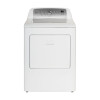Haier HLTD500AGW User Manual - Page 15
Burner Input Requirements, Exhaust System Requirements
 |
View all Haier HLTD500AGW manuals
Add to My Manuals
Save this manual to your list of manuals |
Page 15 highlights
BURNER INPUT REQUIREMENTS Elevations up to 10,000 ft. (3,048 m): r The design of this dryer is certinjed by CSA International for use at altitudes up to 10,000 ft. (3,048 m), above sea level at the B.T.U. rating indicated on the model/ serial number plate. Burner input adjustments are not required when the dryer is operated up to this elevation. Elevations above 10,000 ft. (3,048 m): r When installed above 10,000 ft. (3,048 m) a 4% reduction of the burner B.T.U. rating shown on the model/serial number plate is required for each 1,000 ft. (305 m) increase in elevation. Gas supply pressure testing: r The dryer must be disconnected from the gas supply piping system during pressure testing at pressures greater than 1/2 psi (3.5kPa). EXHAUST SYSTEM REQUIREMENTS WARNING This section describes the requirements for a safe and efficient exhaust system. Failure to follow these instructions can result in poor dryer performance, damage to the dryer, and a fire hazard. IMPORTANT: The dryer must be exhausted to the outdoors. r The dryer shall not be exhausted into any gas vent, chimney, wall, ceiling, attic, crawl space, or concealed space of a building. DUCTING r If your current exhaust system is constructed of plastic or metal foil Ǎexible ducting, replace it with rigid metal ducting. r Use only 4" (10.2 cm) diameter rigid metal ducting. r When making turns in the ductwork, use 45° elbows rather than 90° elbows. This provides better airǍow and can reduce the accumulation of lint in the exhaust system. 90° - Good 45° - Better r Do not exceed the length of duct pipe for the number of elbows shown in the chart below. Doing so can cause an accumulation of lint, an increase in drying time, and the creation of a njre hazard. r Two 45° elbows equal one 90° elbow. 13















